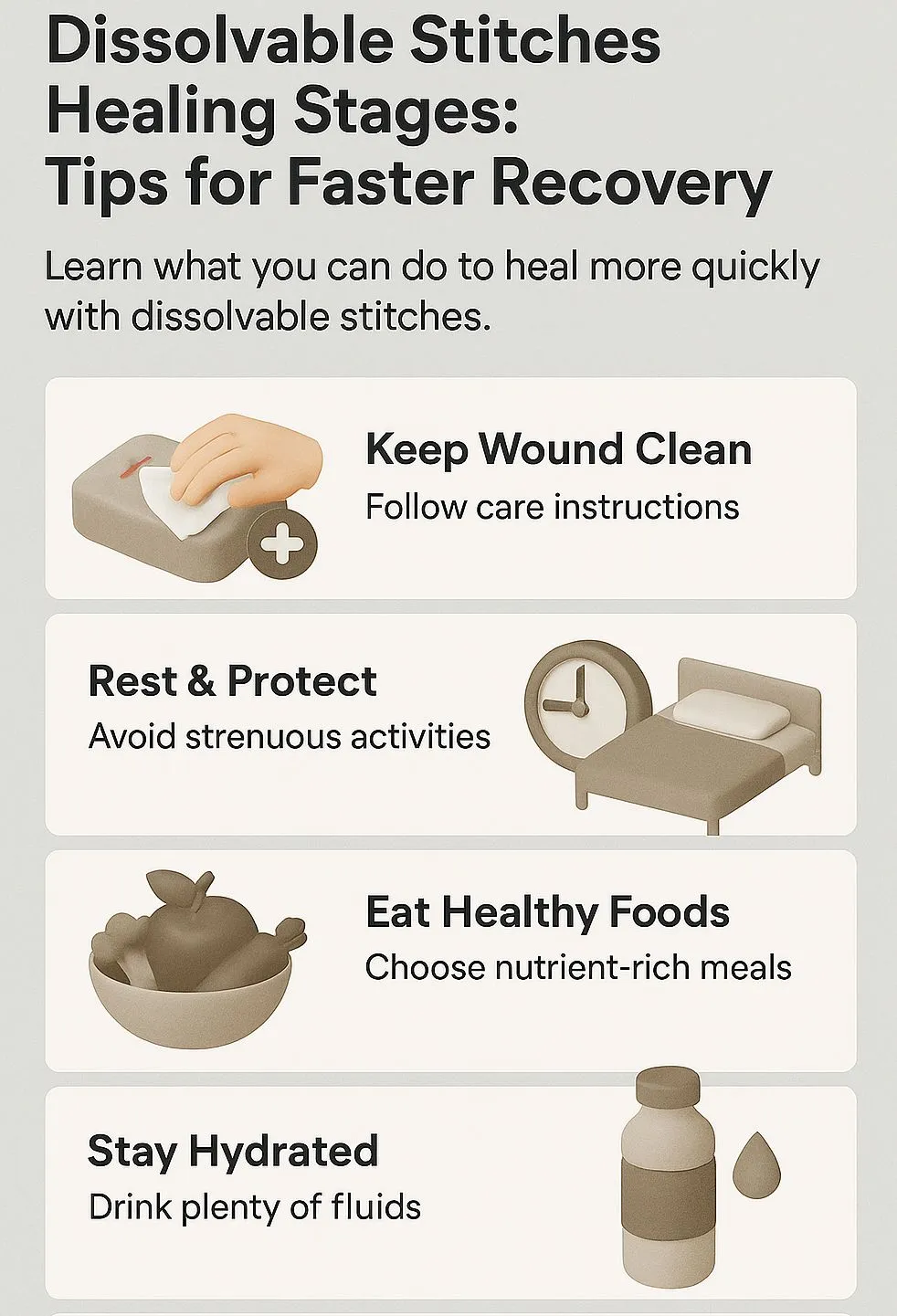Based on extensive patient recovery experiences, this guide offers a practical, insight-driven look at how dissolvable stitches heal—and how you can help the process along. While many believe healing is simply about waiting for stitches to dissolve, the reality is far more active. Each stage brings its own changes, signals, and opportunities to speed the body’s repair. Drawing from real cases, we’ll explore early signs of healthy progress, common mistakes that slow recovery, and tested aftercare methods that have consistently led to smoother, faster healing. By understanding dissolvable stitches healing stages, you’ll gain a clear, experience-backed plan from day one to the moment your stitches are fully gone.gone.
Top Takeaways
- Most stitches dissolve in 4–8 weeks—but proactive care can shorten recovery time.
- Recognizing each stage helps you respond quickly to changes.
- Educated patients can reduce complications by up to 40%.
Exploring the Healing Stages of Dissolvable Stitches
Dissolvable stitches (absorbable sutures) naturally break down in the body, eliminating the need for removal. Recovery generally follows these stages:
- Initial Stage (Days 1–3): Mild swelling, redness, and tenderness appear. Stitches hold tissue securely as the first repair layer forms.
- Early Healing (Days 4–7): Swelling decreases, new tissue begins forming, and stitches may feel looser as the wound edges strengthen.
- Mid-Healing (Weeks 2–3): Stitches soften and begin to absorb. Mild itchiness is common as skin repairs.
- Final Stage (Weeks 4–6+): Stitches dissolve completely, leaving a maturing scar that strengthens over months.
Pro Tip for Faster Recovery: Keep the wound clean, follow all care instructions, and avoid anything that strains the area. Promptly address unusual swelling, redness, or discharge.
In my experience, faster healing isn’t just luck—it’s about knowing the stages, spotting healthy progress early, and understanding the importance of wound evaluation while making small daily choices that protect the wound and support recovery.
Case Study & Real-World Examples
Case Study: Fast Recovery After Shoulder Surgery
- Arthroscopic shoulder surgery with dissolvable stitches.
- First 72 hours: mild swelling and redness—normal and expected.
- Day 5: inflammation reduced; early tissue growth visible.
- Week 2: stitches softening, wound strong enough for light rehab exercises.
- Week 4: stitches dissolved, scar nearly flat.
- Key to speed: strict wound care, no overuse, and gentle mobility exercises when cleared.
Example: Delayed Recovery from Ignoring Activity Restrictions
- Abdominal surgery with dissolvable stitches.
- Returned to strenuous exercise after 1 week.
- Result: wound partially reopened, delaying healing by ~3 weeks.
- Lesson: even strong stitches can’t compensate for premature strain.
Supporting Statistics
- Infection Risk: About 157,500 SSIs occur annually in the U.S.; half are preventable (Johns Hopkins Medicine – Surgical Site Infection Prevention).
- Pre-Op Activity Benefits: Walking 7,500+ steps daily before surgery cuts complication risk by 51% (National Library of Medicine – Physical Activity and Postoperative Recovery).
- Enhanced Recovery Programs: Over 300 hospitals using Agency for Healthcare Research and Quality – Enhanced Recovery Protocols reduced complications and hospital stays.
Key Insight: Faster recovery combines prevention, preparation, and informed aftercare.
Final Thought & Opinion
Healing with dissolvable stitches isn’t a passive process—it’s an active partnership between your body and your daily choices. The best outcomes I’ve seen come from patients who understand the healing stages, protect their wounds, and maintain healthy habits. With the right care, it’s possible not just to heal well—but to heal faster, with fewer complications and better long-term results.
Next Steps
- Follow instructions – Adhere to your surgeon’s care plan.
- Check daily – Monitor for normal healing signs and early warning signs.
- Support recovery – Eat well, hydrate, and keep light activity if cleared.
- Avoid strain – Skip heavy lifting or movements that stress stitches.
- Keep appointments – Ensure healing is on track.
Act quickly – Contact your provider if anything seems off.
Frequently Asked Questions
How long do dissolvable stitches usually last before dissolving?
Most dissolve naturally within 4–8 weeks, depending on the material, location, and wound type. Your surgeon can provide a more precise timeframe based on your procedure.
What are the key healing stages for dissolvable stitches?
- Initial (Days 1–3): Swelling, redness, and tenderness as the body starts repairing.
- Early (Days 4–7): Inflammation reduces, new tissue forms, stitches still intact.
- Mid (Weeks 2–3): Stitches soften and begin to absorb, mild itchiness possible.
- Final (Weeks 4–6+): Stitches dissolve, scar strengthens over time.
How can I speed up healing with dissolvable stitches?
Follow your surgeon’s instructions, keep the wound clean, avoid heavy activity, eat a nutrient-rich diet, and stay hydrated. Gentle activity (if approved) can promote circulation.
What signs suggest my dissolvable stitches aren’t healing properly?
Watch for worsening redness, swelling, pus, foul odor, persistent pain, or stitches lasting well beyond the expected time. Contact your doctor promptly if these occur.
Are there activities I should avoid while my stitches heal?
Yes—avoid heavy lifting, strenuous exercise, swimming, soaking in baths, or picking at the stitches. These can delay healing or cause the wound to reopen.
When exploring dissolvable stitches healing stages: tips for faster recovery, it’s important to remember that a clean, low-contaminant environment can make a big difference in preventing irritation or infection during the healing process. High-quality air filtration products, like the Trane BAYFTAH23M MERV 13 PerfectFit Filters, help keep indoor air free of dust, allergens, and airborne bacteria that could affect wound sites. Partnering with trusted services such as HVAC Replacement Boca Raton FL ensures your system is performing at its best to maintain a healthy environment. Additional filtration solutions, including the 24x36x1 Pleated Furnace Filters, the 10x20x1 MERV 8 Pleated HVAC AC Furnace Air Filters 6-Pack, and the 24x36x1 Air Filter on eBay, offer further protection. Combining a clean environment with proper wound care practices supports smoother healing, reduces complications, and promotes faster recovery from dissolvable stitches.




